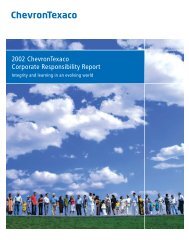Energizing California - Chevron
Energizing California - Chevron
Energizing California - Chevron
You also want an ePaper? Increase the reach of your titles
YUMPU automatically turns print PDFs into web optimized ePapers that Google loves.
<strong>Energizing</strong> <strong>California</strong><br />
Milken Institute<br />
Based on the North American Industry Classification System (NAICS) and according to Bureau of Labor Statistics<br />
(BLS) guidelines, <strong>Chevron</strong>’s primary economic activity falls under the following eleven NAICS codes:<br />
<strong>Chevron</strong>'s primary industries<br />
By NAICS code<br />
NAICS<br />
Code Industry<br />
211111 Crude petroleum and natural gas extraction<br />
212111 Bituminous coal and lignite surface mining<br />
324110 Petroleum refineries<br />
324191 Petroleum lubricating oil and grease manufacturing<br />
424690 Other chemical and allied merchant wholesalers<br />
424720 Petroleum and petroleum products merchant wholesalers*<br />
483111 Deep-sea freight transportation<br />
483113 Coastal and Great Lakes transportation<br />
486110 Pipeline transportation of crude<br />
531190 Lessors of other real estate property<br />
541320 Landscape architectural services**<br />
Sources: Office of Management and Budget, <strong>Chevron</strong>.<br />
*Except bulk stations and terminals; **Includes planning and designing the development of land areas for projects.<br />
The Bureau of Economic Analysis (BEA) assigns unique coefficients, known as “multipliers,” to these industry<br />
codes in order to help capture the extent of the economic impacts stemming from the industry and its location.<br />
Until we apply these multiplicative values to <strong>Chevron</strong>’s current size, it is difficult to fully grasp the firm’s total<br />
effect on the state economy.<br />
Multipliers enable us to quantify how employment, earnings, and output generated by an industry within a<br />
region ripple through and impact other regional economic sectors. In addition to providing data on an industry’s<br />
regional impact, economic multipliers also bring to light region-wide interdependencies and inter-industry<br />
relationships. It is important to highlight these relationships because they directly influence how regional<br />
economies respond to changes in long-term industry structures and business cycles.<br />
The jobs <strong>Chevron</strong> directly generates, the earnings per employee, the tax revenue it generates, and the output it<br />
creates comprise its direct impacts on the state economy. These direct impacts also have an additional, broader<br />
benefit: They immediately translate into economic stimulus for other sectors that support the industry (such as<br />
services, trade, and construction).<br />
<strong>Chevron</strong>’s presence creates an opportunity for supplier industries to service the company’s operations and<br />
meet its continuous demand for technological improvements and value-added services. An example of such<br />
an indirect impact occurs when the company hires subcontractors or contracts with vendors in support of its<br />
production processes. The extent of the impact is typically determined through the length and characteristics of<br />
the supply chain throughout the region. A longer and higher-quality supply chain has a greater overall impact in<br />
a region—and the employment multiplier for the petroleum refinery industry in <strong>California</strong> is relatively high. The<br />
industry requires an extensive production infrastructure and a large proportion of highly skilled and specialized<br />
labor, including many researchers and engineers. With this need comes a higher demand for supply-related<br />
goods and services, which are likely to stem from the same region.<br />
12

















